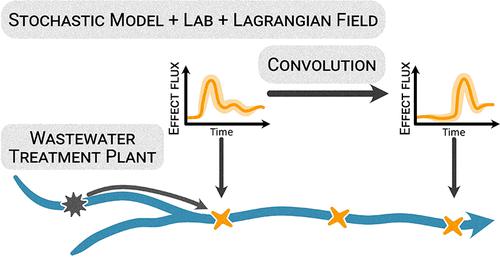当前位置:
X-MOL 学术
›
Environ. Sci. Technol.
›
论文详情
Our official English website, www.x-mol.net, welcomes your
feedback! (Note: you will need to create a separate account there.)
Modeling the Dynamics of Mixture Toxicity and Effects of Organic Micropollutants in a Small River under Unsteady Flow Conditions
Environmental Science & Technology ( IF 10.8 ) Pub Date : 2022-09-28 , DOI: 10.1021/acs.est.2c02824 Ran Wei 1 , Beate I Escher 1, 2 , Clarissa Glaser 1 , Maria König 2 , Rita Schlichting 2 , Markus Schmitt 1 , Anna Störiko 1 , Michelle Viswanathan 3 , Christiane Zarfl 1
Environmental Science & Technology ( IF 10.8 ) Pub Date : 2022-09-28 , DOI: 10.1021/acs.est.2c02824 Ran Wei 1 , Beate I Escher 1, 2 , Clarissa Glaser 1 , Maria König 2 , Rita Schlichting 2 , Markus Schmitt 1 , Anna Störiko 1 , Michelle Viswanathan 3 , Christiane Zarfl 1
Affiliation

|
The presence of anthropogenic organic micropollutants in rivers poses a long-term threat to surface water quality. To describe and quantify the in-stream fate of single micropollutants, the advection–dispersion–reaction (ADR) equation has been used previously. Understanding the dynamics of the mixture effects and cytotoxicity that are cumulatively caused by micropollutant mixtures along their flow path in rivers requires a new concept. Thus, we extended the ADR equation from single micropollutants to defined mixtures and then to the measured mixture effects of micropollutants extracted from the same river water samples. Effects (single and mixture) are expressed as effect units and toxic units, the inverse of effect concentrations and inhibitory concentrations, respectively, quantified using a panel of in vitro bioassays. We performed a Lagrangian sampling campaign under unsteady flow, collecting river water that was impacted by a wastewater treatment plant (WWTP) effluent. To reduce the computational time, the solution of the ADR equation was expressed by a convolution-based reactive transport approach, which was used to simulate the dynamics of the effects. The dissipation dynamics of the individual micropollutants were reproduced by the deterministic model following first-order kinetics. The dynamics of experimental mixture effects without known compositions were captured by the model ensemble obtained through Bayesian calibration. The highly fluctuating WWTP effluent discharge dominated the temporal patterns of the effect fluxes in the river. Minor inputs likely from surface runoff and pesticide diffusion might contribute to the general effect and cytotoxicity pattern but could not be confirmed by the model-based analysis of the available effect and chemical data.
中文翻译:

模拟不稳定流动条件下小河流中有机微污染物的混合物毒性和影响的动力学
河流中存在人为有机微污染物对地表水质量构成长期威胁。为了描述和量化单一微污染物的流内命运,之前使用了平流-分散-反应 (ADR) 方程。了解由微污染物混合物在河流中沿其流动路径累积引起的混合物效应和细胞毒性的动力学需要一个新概念。因此,我们将 ADR 方程从单一微污染物扩展到定义的混合物,然后扩展到从同一河流水样中提取的微污染物的测量混合效应。效应(单一和混合)表示为效应单位和毒性单位,分别是效应浓度和抑制浓度的倒数,使用一组体外生物测定进行量化。我们在不稳定流下进行了拉格朗日采样活动,收集了受废水处理厂 (WWTP) 流出物影响的河水。为了减少计算时间,ADR 方程的解由基于卷积的反应传输方法表示,用于模拟效果的动态。单个微污染物的消散动力学由确定性模型按照一级动力学进行再现。通过贝叶斯校准获得的模型集合捕获了没有已知成分的实验混合效应的动力学。高度波动的污水处理厂出水排放主导了河流中效应通量的时间模式。
更新日期:2022-09-28
中文翻译:

模拟不稳定流动条件下小河流中有机微污染物的混合物毒性和影响的动力学
河流中存在人为有机微污染物对地表水质量构成长期威胁。为了描述和量化单一微污染物的流内命运,之前使用了平流-分散-反应 (ADR) 方程。了解由微污染物混合物在河流中沿其流动路径累积引起的混合物效应和细胞毒性的动力学需要一个新概念。因此,我们将 ADR 方程从单一微污染物扩展到定义的混合物,然后扩展到从同一河流水样中提取的微污染物的测量混合效应。效应(单一和混合)表示为效应单位和毒性单位,分别是效应浓度和抑制浓度的倒数,使用一组体外生物测定进行量化。我们在不稳定流下进行了拉格朗日采样活动,收集了受废水处理厂 (WWTP) 流出物影响的河水。为了减少计算时间,ADR 方程的解由基于卷积的反应传输方法表示,用于模拟效果的动态。单个微污染物的消散动力学由确定性模型按照一级动力学进行再现。通过贝叶斯校准获得的模型集合捕获了没有已知成分的实验混合效应的动力学。高度波动的污水处理厂出水排放主导了河流中效应通量的时间模式。









































 京公网安备 11010802027423号
京公网安备 11010802027423号